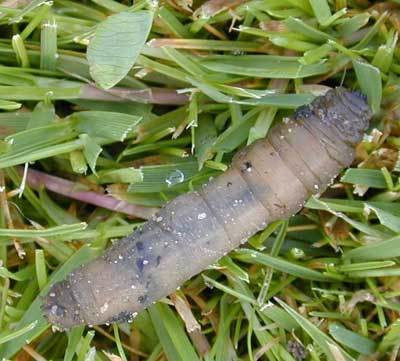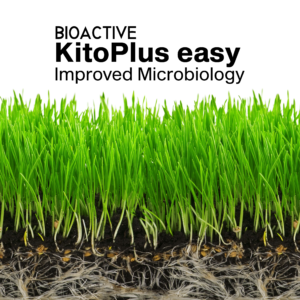As greenkeepers, we are increasingly facing a myriad of challenges in maintaining our greens. The warming climate has led to a surge in numbers and frequency of outbreaks of previously infrequent problem insect pests such as leatherjackets and chafer grubs, which can cause significant damage to the turf. Additionally, the increased prevalence of fungal diseases, coupled with symptoms driven turf management due to out-dated maintenance practices, further exacerbate these challenges.
While the recent emergency approval of Chlorantraniliprole-based insecticides may seem like a quick fix to the problem of leatherjacket and chafer infestations, it’s important to consider the potential downsides. This approach is largely symptom-driven, focusing on the immediate issue of pest infestation rather than addressing the underlying health of the soil ecosystem.
Reliance on such insecticides can disrupt the natural balance of soil microbiology, potentially harming beneficial organisms and leading to a cycle of dependency where the soil becomes less resilient and more susceptible to future pest outbreaks. Furthermore, Chlorantraniliprole, like all chemical pesticides, carries risks of environmental contamination and potential harm to non-target species, including beneficial insects and aquatic life. It’s a reminder that while such measures might offer temporary relief, they are not a sustainable long-term solution to pest management.
Amidst these difficulties, the withdrawal of pesticides presents us with an unexpected silver lining. Rather than viewing this as a setback, it can be seen as a positive force, pushing us to leverage our knowledge and skills to work smarter and in harmony with nature. This shift in approach encourages the exploration and exploitation of the natural mechanisms and symbioses that grass plants have evolved over millennia to thrive in diverse environments worldwide. By harnessing these natural processes, we can promote healthier, more resilient greens, turning challenges into opportunities for innovation and sustainable practices.
Choose Life, Choose Chitin
Chitin, a component of the exoskeletons of soil borne arthropods, the cell walls of fungi and most interestingly the exoskeletons of insect larvae such as leatherjackets, plays a crucial role in soil health. It provides structural support and protection for these organisms. When insects, such as grubs, shed their exoskeletons or die, the chitin in their bodies can be broken down by certain microorganisms in the soil, contributing to the soil’s organic matter and nutrient content.. When added to the soil, it breaks down into chitosan, a substance that can enhance plant growth, improve soil structure, and stimulate beneficial soil microorganisms. These microorganisms, in turn, can help control harmful pests and diseases, making the soil more resilient and productive.
However, in overly managed turf, where the norm has been to maintain with pesticides, high salt mineral fertilisers, and an overabundance of sand, the soil can become almost inert in terms of microbiology. This means that the natural processes that break down chitin and other organic matter are disrupted, leading to a deficiency of beneficial substances like chitosan.
In essence, the soil becomes less like a living ecosystem and more like an artificial growing medium, lacking the complex web of life that helps plants thrive. By reducing our reliance on artificial inputs and reintroducing natural substances like chitin or chitosan directly, we can help restore the soil’s natural balance, promoting healthier, more resilient turf.
Chitosan is a naturally occurring polysaccharide derived from chitin, a major component of crustacean shells, fungi cell walls, and insect exoskeletons. It has gained significant attention in the field of agriculture due to its biodegradability, non-toxicity, and antimicrobial properties.
In the soil ecosystem, chitosan plays a crucial role in enhancing plant growth and productivity. It does this through several mechanisms:
- Soil Conditioning: Chitosan improves soil structure by promoting the aggregation of soil particles. This enhances water retention and nutrient availability, leading to improved plant growth.
- Plant Health: Chitosan has been found to stimulate plant defences, making them more resistant to diseases. It does this by inducing the production of chitinases, enzymes that degrade the cell walls of pathogenic fungi.
- Microbiological Associations: Chitosan influences the soil microbiome, the community of microorganisms living in the soil. It can suppress harmful microbes while promoting the growth of beneficial ones. For instance, it can enhance the activity of nitrogen-fixing bacteria, which convert atmospheric nitrogen into a form that plants can use.
- Biocontrol Agent: Due to its antimicrobial properties, chitosan can be used as a biocontrol agent to manage soil-borne pathogens. It disrupts the cell walls of these pathogens, inhibiting their growth.
- Bioremediation: Chitosan can also play a role in bioremediation, the process of using organisms to neutralise or remove contaminants from the environment. It can bind to heavy metals in the soil, reducing their bioavailability and toxicity.
Practical Greenkeeping Steps with Chitin
BioActive KitoPlus Easy 1500 m2 green: 300 ml diluted in 30 L water. Apply five times per year in March, April, June, September and October and leave a minimum of two weeks between applications.
Chitosan has a multifaceted role in the soil ecosystem, contributing to soil health, plant growth, and disease and pest resistance. Its interactions with soil microorganisms are particularly important, influencing both the structure and function of the soil microbiome.
For a more detailed understanding, I recommend referring to some of the abundant scientific literature on the subject, some of which is listed below.
Research
According to the paper, Streptomycetes, a type of Actinomycetes, are thought to be one of the major chitinivorous microbial groups in soil due to their ability to degrade chitin. This has long been regarded as a characteristic feature of soil streptomycetes. Other bacteria were less important (1–3 %) and fungi formed less than 1 % of the chitinivorous population on chitin agar plates.
Here are some more research papers that discuss the relationship between soil bacteria, including those potentially influenced by chitosan, and their role in attacking insect pests:
- Resistance to Bacillus thuringiensis Mediated by an ABC Transporter Mutation Increases Susceptibility to Toxins from Other Bacteria in an Invasive Insect – This study discusses how resistance to a toxin produced by the bacterium Bacillus thuringiensis in the crop pest, Helicoverpa armigera, increased its susceptibility to other bacterial insecticides. Full Text
- Bacteria from the Midgut of Common Cockchafer (Melolontha melolontha L.) Larvae Exhibiting Antagonistic Activity Against Bacterial Symbionts of Entomopathogenic Nematodes: Isolation and Molecular Identification – This study found that bacteria inhabiting the gut of insects might play a key role in insect resistance to entomopathogenic nematode pressure. Full Text
- Entomopathogenic microorganisms: their role in insect pest management – This review discusses the role of entomopathogenic microorganisms, including bacteria, in managing insect pests. Full Text
- Phylogenetically closely related pseudomonads isolated from arthropods exhibit differential insect-killing abilities and genetic variations in insecticidal factors – This study found that closely related pseudomonads isolated from arthropods showed varying levels of insecticidal activity. Full Text



John,
Thanks for the useful research you provide for us. Regarding Chlorantraniliprole (aka Acelepryn), it appears to have been given full approval in Spring 2023 for chafer grubs and leatherjackets in bowling greens – is that ongoing approval or temporary?
Is there any value in using Acelepryn once to knock back the leatherjackets while continuing with the various measures you have recommended such as KitoPlus and Formula Green, etc? Or will Acelepryn undo the good work of trying to improve the soil microbes?
There is a strange restriction on the manufacturer’s datasheet: ‘The total surface area treated must not exceed 10% of the total area of managed amenity turf (with the exception of residential lawn use), or amenity grassland in any given situation’. Sounds like it could only be applied to 10% of a bowling green which is not very useful.
Your thoughts?
Hi Frank
Group 28 Insecticides are among the least attractive substances to have around your green. They are nerve acting chemicals and are banned for use on amenity turf for good reasons. This one is occasionally approved for use as an emergency application as you have seen.
Purchase and application of Chlorantraniliprole would need to be by someone with a pesticide application certificate and application and storage would need to conform to COSHH and general Pesticides Regulations and also LERAP regulations as it is potentially hazardous to bees and toxic to aquatic life with long lasting effects. There would probably also be access restrictions after application, but you’d need to check to find out what these are.
The emergency approval mentioned allows you to apply it to no more than 10% of your managed turf, so you would only be able to use 10ml or so at any given approval period. This also brings up the issue of trying to decide which 10% of your green is going to be affected most by the insects. If your club has at least 1.5 Ha of amenity turf in total, then there is a potential workaround, where you could claim your green is 10% of this total, but I’m not sure if that is acceptable or not in the law and would mean that the rest of your turf would have to take its chances.
I recently published a post about concentrating on and enhancing natural, in-built plant mechanisms for leatherjacket control here: https://bowls-central.co.uk/grass-root-defences-leatherjacket-control-in-bowling-greens/
If you really do find yourself in an emergency situation with lots of grubs appearing, you can easily remove them by watering the green and then covering it (a section each evening) with black plastic damp proof sheeting. B&Q or Wickes will sell you a big roll. You simply pick or mow the grubs off in the morning. Next evening you repeat it on the next section and so on, until one morning you see hardly any grubs. This is a guaranteed method to eradicate leatherjackets that are already in your green causing damage.
A large hatch of leatherjackets can wipe out your entire green, but you needn’t ever get to that stage if you are vigilant. Best thing is not to worry about this as there is a lot of proactive work you can do, much of which is covered in the article. Even the worst case scenario isn’t that bad anyway, as long as you have a roll of Damp Proof Membrane in the shed. Keep sampling and checking and watch the birds for an early alert to any problems.
Regards
John
Very helpful comments – thanks John. We tried the black plastic sheeting last year and got a lot of grubs but it didn’t stop a serious hatching in the autumn. I was hoping the less labour-intensive nematode treatments would do the job, and maybe there are less grubs than before, but there are still plenty. I’ll give your recommended plant-strengthening treatments next season and keep my fingers crossed.